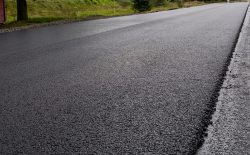Why Does Asphalt Get So Hot?

Sunlight and Absorption
One of the primary reasons asphalt gets so hot is due to its dark color and ability to absorb sunlight. Asphalt is typically black or dark gray in color, which helps to absorb more solar radiation than lighter-colored surfaces. When sunlight hits the asphalt, its surface absorbs the energy, converting it into heat. This phenomenon is known as solar radiation absorption.
Thermal Conductivity
Another factor that contributes to the high temperature of asphalt is its low thermal conductivity. Asphalt is a relatively poor thermal conductor, meaning it does not transfer heat efficiently. Unlike materials with higher thermal conductivity, such as metals, asphalt retains heat for longer periods. Therefore, even after the sun sets, asphalt surfaces remain hotter compared to other materials.
Heat Retention
Asphalt has a high heat retention capacity that allows it to store and accumulate heat throughout the day. During sunny periods, asphalt absorbs large amounts of solar energy, heating up rapidly. As a result, it can retain the absorbed heat for an extended period, causing it to feel much hotter than other surface materials, such as concrete or grass.
Lack of Vegetation
Unlike grass or other green surfaces, asphalt lacks any form of vegetation or foliage to provide shade or evaporative cooling. Trees and plants have a natural cooling effect through the process of transpiration, where they release moisture into the air. Since asphalt lacks this natural cooling mechanism, it remains exposed to the sun’s rays, leading to higher temperatures.
Heat Island Effect
The heat island effect also contributes to the intense heat experienced on asphalt surfaces. Urban areas with large amounts of asphalt and concrete tend to create urban heat islands, where temperatures are higher compared to the surrounding rural areas. The dark color and heat-retaining properties of asphalt contribute to the heat island effect by trapping and radiating heat, creating localized hotspots.
Asphalt Composition
The composition of asphalt itself also plays a role in its heat-absorbing properties. Asphalt mixtures are typically made of aggregates, binders, and additives. The aggregates, commonly crushed stones, retain heat well due to their dense nature. The binders, usually bitumen, also absorb heat and contribute to the overall high temperature of asphalt. Additives, such as polymers, can be included to modify the properties of asphalt to make it more resistant to temperature fluctuations, but they do not significantly reduce its heat-absorbing tendencies.
Imperviousness to Water
Asphalt is an impervious material, meaning it does not allow water to pass through easily. When it rains or water is sprayed on asphalt surfaces, it tends to remain on the surface, leading to less evaporative cooling compared to permeable surfaces such as grass or soil. The lack of evaporative cooling further contributes to the retention of heat on asphalt surfaces, intensifying their hotness.
Environmental Factors
Besides the inherent properties of asphalt, environmental factors also influence its temperature. The intensity and duration of sunlight, air temperature, and surrounding environmental conditions all impact the heat experienced on asphalt surfaces. Regions with higher solar radiation, longer summer seasons, and hotter climates will naturally experience hotter asphalt surfaces compared to cooler areas with less sunshine.
Conclusion
Asphalt becomes so hot primarily due to its dark color, solar radiation absorption, low thermal conductivity, and heat retention properties. The lack of vegetation, the heat island effect, asphalt composition, imperviousness to water, and environmental factors further compound the heat experienced on asphalt surfaces. Understanding these factors can help us find ways to mitigate the heat emitted by asphalt, leading to more comfortable experiences for pedestrians and drivers alike.
Got Questions? Let Us Help!
Categorised in: Asphalt
This post was written by admin
